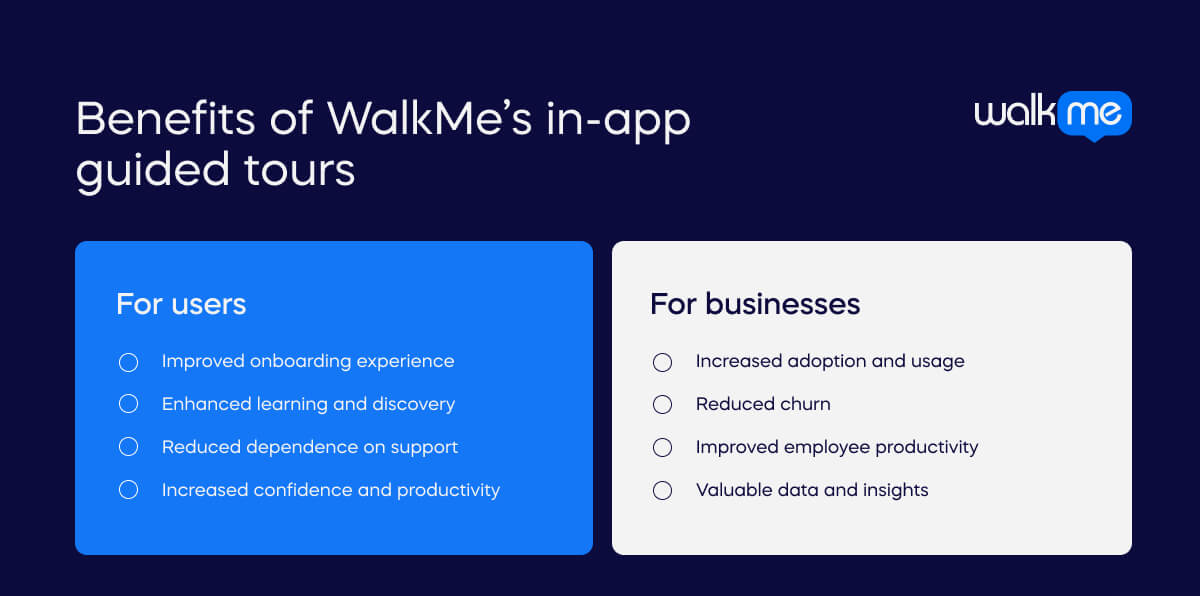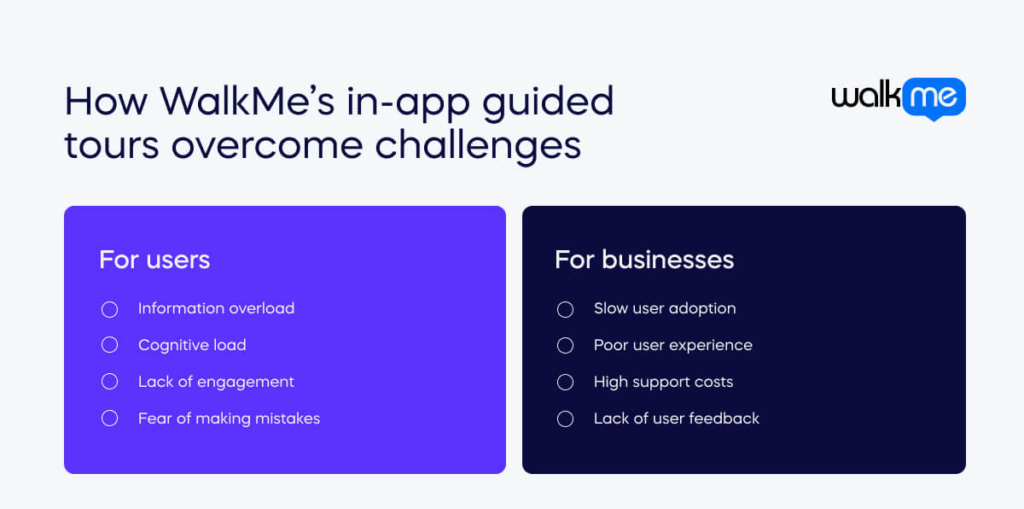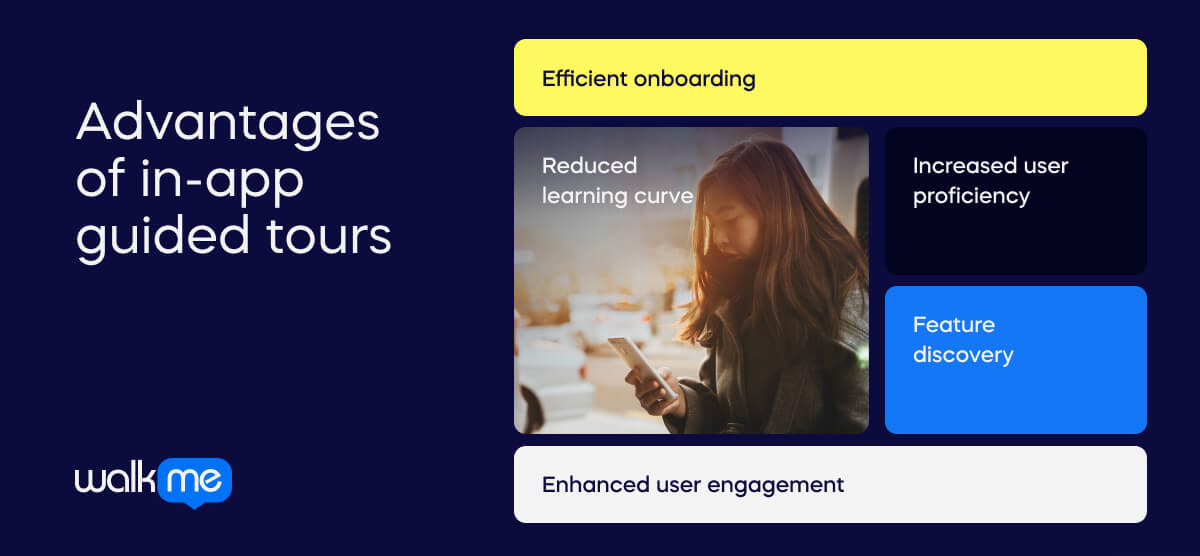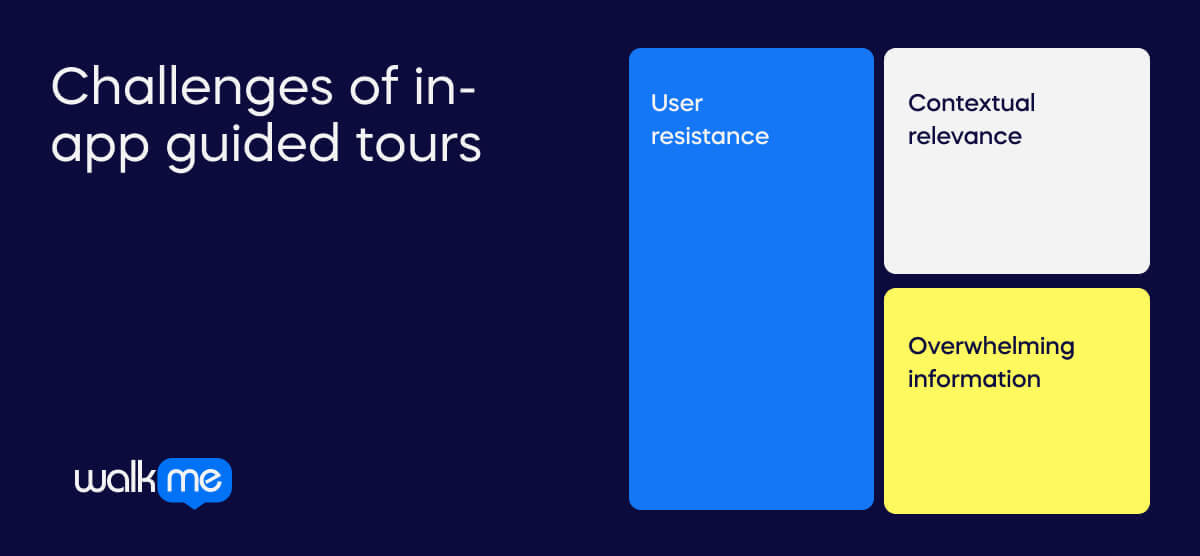What are in-app guided tours?
In-app guided tours refer to a user interface (UI) feature within a software application or platform that provides step-by-step instructions or walkthroughs to help users navigate and understand the application’s functionalities.

Table of contents
- What are in-app guided tours?
- Why are in-app guided tours important?
- Use cases for in-app guided tours
- In-app guided tours with WalkMe
- Examples of in-app guided tours
- Advantages of in-app guided tours
- Challenges of in-app guided tours
- Transformative navigation: In-app guided tours as strategic catalysts for digital success
These guided tours are designed to assist users in getting familiar with the features, settings, and overall user interface of the app.
Similar to a physical tour guide leading visitors through a new place, in-app guided tours aim to provide a virtual guide within the application itself.
These tours often include interactive elements, tooltips, and prompts highlighting specific buttons, menus, or actions, guiding users through key tasks or processes.
The goal is to enhance user onboarding, reduce learning curves, and ensure users can maximize the application’s capabilities.
For example, an in-app guided tour for a project management application might walk a new user through creating a project, assigning tasks, and utilizing collaboration features.
Embedded within the interactive landscape of modern software applications, in-app guided tours are indispensable aids, strategically prioritizing user proficiency over mere navigational familiarity.
In this dynamic digital era, in-app guided tours act as a transformative force, reshaping user interactions and processes, driving positive change, and elevating the overall user experience within the software ecosystem.
Why are in-app guided tours important?
In-app guided tours are crucial for enhancing user onboarding experiences by providing step-by-step assistance, ensuring users quickly grasp the functionalities of software applications.
WalkMe’s in-app guided tours offer many benefits for both users and businesses.
Here are some of the key advantages:
Benefits of WalkMe’s in-app guided tours

For users
Improved onboarding experience: WalkMe’s interactive tours guide new users through the interface and key features, making the onboarding process smoother and less overwhelming. This can significantly reduce the time it takes for users to become productive.
Enhanced learning and discovery: The tours can highlight hidden features and functionalities that users might not find on their own, encouraging them to explore the app’s full potential. This can lead to increased engagement and satisfaction.
Reduced dependence on support: By providing contextual help and troubleshooting tips, WalkMe can help users resolve common issues independently, reducing the need to contact support. This can save both users’ and businesses’ time and resources.
Increased confidence and productivity: By giving users a better understanding of the app, WalkMe can help them feel more confident and productive in their work. This can lead to improved performance and overall job satisfaction.
For businesses
Increased adoption and usage: By making it easier for users to learn and use the app, WalkMe can help businesses drive digital adoption and usage rates. This can lead to increased revenue and return on investment (ROI).
Reduced churn: By improving the user experience and reducing frustration, WalkMe can help businesses retain customers and reduce churn. This can save businesses money and help them grow.
Improved employee productivity: By enabling employees to learn and use the app more effectively, WalkMe can help businesses enhance employee productivity. This can lead to increased efficiency and cost savings.
Valuable data and insights: WalkMe provides businesses with valuable data and insights on how users interact with the app. This data can be used to improve the app and make it more user-friendly.
How WalkMe’s in-app guided tours overcome challenges

WalkMe’s in-app guided tours address various challenges faced by users and businesses related to software adoption and usage.
Here’s how they overcome some of the most common ones:
For users
Information overload: Complex applications often overwhelm users with too much information at once. WalkMe’s tours break down the interface and features into bite-sized, contextual steps, making the learning process more manageable.
Cognitive load: Remembering multiple features and workflows can be mentally taxing. WalkMe’s step-by-step guidance reduces cognitive load by providing clear instructions and reminders at the right moment.
Lack of engagement: Traditional static user manuals can be dull and uninspiring. WalkMe’s interactive tours use gamification elements and storytelling techniques to keep users engaged and motivated.
Fear of making mistakes: Trying new features can be daunting for users worried about making mistakes. WalkMe’s tours provide a safe environment to experiment and learn without fear of consequences.
For businesses
Slow user adoption: Getting users to adopt and use new software can be a slow and expensive process. WalkMe’s tours accelerate adoption by making the learning process quicker and easier.
Poor user experience: A confusing or frustrating user experience can lead to low engagement and churn. WalkMe’s tours help businesses improve the user experience by making the app more intuitive and user-friendly.
High support costs: Providing support for new users can be costly for businesses. WalkMe’s self-service tours deflect support tickets and reduce the need for live assistance.
Lack of user feedback: It can be difficult to get valuable feedback from users about their experience with the app. WalkMe’s tours can be used to collect user feedback and insights, which can be used to improve the app.
Use cases for in-app guided tours
In the business landscape, in-app guided tours play a pivotal role by accelerating employee onboarding, ensuring swift adaptation to new digital tools, and fostering heightened operational efficiency.
By guiding users through critical workflows, these tours empower businesses to streamline processes, reduce training overhead, and optimize overall software utilization for enhanced productivity.
Here are some examples:
In-app guided tours in business
Software onboarding and feature adoption
In software development, in-app guided tours find practical applications during onboarding.
For instance, when users subscribe to a new project management tool, a guided tour can lead them through creating projects, assigning tasks, and collaborating with team members.
This ensures quick and effective feature adoption, minimizing the time users need to explore functionalities independently.
E-commerce platforms and new features introduction
E-commerce platforms regularly introduce new features, such as personalized recommendations or loyalty programs.
In-app guided tours can guide users through these updates, explaining how to navigate the new features, take advantage of discounts, or redeem loyalty points.
This enhances user engagement and encourages users to explore and utilize the platform’s latest offerings.
Learning management systems in education
Educational platforms can employ in-app guided tours to assist both students and educators in navigating complex learning management systems.
The tours may cover functionalities like submitting assignments, participating in discussions, and accessing learning resources.
This application ensures a smooth transition for users, especially those new to online education platforms.
Financial applications and transaction processes
In financial applications, in-app guided tours can guide users through transaction processes.
For example, a banking app might use guided tours to explain how to transfer funds, set up recurring payments, or view transaction history.
This enhances user confidence in using the app and reduces the likelihood of errors during financial transactions.
In-app guided tours with WalkMe
WalkMe’s in-app guided tours, features, and functionalities work together in a powerful synergy, enhancing user experiences and driving application efficiency.
Here’s how:
WalkMe launchers: These contextual triggers automatically launch relevant tours based on user actions or specific app screens. Imagine a tour popping up when a user reaches a complex form, providing step-by-step guidance to fill it out correctly.
WalkMe Spotlight & WalkMe Spotlight Pro: These features highlight specific UI elements or sections of the app within the tour flow, drawing user attention to key features or functionalities they might otherwise miss. Think of it like shining a spotlight on a hidden gem within the app.
Smart Tips and Smart Tips Pro: These proactive mini-tours offer contextual tips and suggestions based on user behavior or specific app states. Imagine a helpful pop-up reminding users about an underutilized feature when it could be most relevant.
Personalization: Tours can leverage WalkMe’s user segmentation and targeting capabilities to deliver personalized experiences for different user groups or roles. Imagine separate tours for new vs. experienced users or marketing vs. sales teams, focusing on their specific needs.
Data-driven insights: Tour analytics within WalkMe provide insights into user engagement, completion rates, and pain points. This data can be used to optimize the tours and identify areas for improvement within the app itself.
Automation and scalability: WalkMe’s automation tools allow you to create and manage large tours efficiently. This makes it easy to scale your guided tour program as your app and user base grow.
Accessibility and compliance: Guided tours can be designed to be accessible for users with disabilities and can help businesses comply with regulations like WCAG. This ensures everyone has an equal opportunity to benefit from the app’s functionalities.
Examples of in-app guided tours
In today’s digital business world, onboarding automation and seamless adoption of software applications are pivotal for businesses aiming to enhance productivity and efficiency.
Let’s explore how industry leaders have harnessed the potential of in-app guided tours to streamline onboarding processes, boost productivity, and enhance overall user satisfaction.
How businesses find success with in-app guided tours
Slack
The popular team collaboration platform utilizes in-app guided tours to highlight features like channel creation, direct messaging, and file sharing. New users are guided through these essential functionalities, ensuring a smooth onboarding process.
This approach has significantly improved user experience by reducing the learning curve for new users. Teams adopting Slack report increased collaboration efficiency, streamlined communication, and faster platform integration into their daily workflows.
Salesforce
This leading customer relationship management (CRM) platform employs in-app guided tours to assist users in tasks such as lead management, opportunity tracking, and report generation. This ensures sales teams can efficiently utilize the CRM for improved customer interactions.
The guided tour approach has increased productivity among sales teams, as they can quickly grasp and implement CRM functionalities. Salesforce users report enhanced data accuracy, streamlined sales processes, and a more robust customer engagement strategy.
Zoom
The widely used video conferencing platform incorporates in-app guided tours with interactive demonstrations. Users can simulate hosting and joining meetings, sharing screens, and managing settings. This hands-on approach facilitates a deeper understanding of the platform’s capabilities.
The interactive demonstrations have led to a more confident user base, resulting in smoother virtual meetings and increased adoption of advanced features. Users report a heightened sense of control over the platform, leading to improved meeting efficiency and overall satisfaction with the Zoom experience.
Driving innovation with Walkme
WalkMe has empowered businesses to achieve their goals and drive success by implementing in-app guided tours.
Here’s how the DAP has assisted industry leaders in delivering tangible benefits for both user-facing applications and internal processes.
DocuSign
DocuSign, a leading e-signature platform, faced challenges with user adoption and onboarding, leading to high support ticket volumes. New users often struggled to navigate the platform’s complex features.
The company implemented WalkMe’s in-app guided tours to provide contextual guidance and step-by-step instructions for key workflows, such as sending and signing documents.
DocuSign achieved significant improvements:
- 20% increase in user adoption: More users completed key tasks within the platform.
- 30% reduction in support tickets: Guided tours deflected support inquiries related to basic functionalities.
- 15% faster onboarding time: New users became more productive with the tours’ help.
L’Oréal
L’Oréal, a global cosmetics company, was experiencing inefficiencies in internal processes due to inconsistent knowledge and workflows across different departments.
They implemented WalkMe’s guided tours to standardize and streamline key internal processes, such as expense reporting, marketing campaign approvals, and inventory management.
L’Oréal observed remarkable improvements:
- 25% reduction in process errors: Standardized workflows minimized mistakes and rework.
- 10% increase in employee productivity: Employees saved time and effort by following optimized workflows.
- Improved employee satisfaction: Consistent and clear processes led to happier and more confident employees.
Advantages of in-app guided tours

In-app guided tours offer several advantages, contributing to enhanced user experiences, increased efficiency, and improved software adoption.
Here are some key advantages:
Efficient onboarding
In-app guided tours streamline the onboarding process for new users, guiding them through key features and functionalities. This accelerates the learning curve, ensuring users quickly become familiar with the software and its capabilities.
Reduced learning curve
By providing step-by-step guidance, in-app tours minimize the time and effort users would otherwise spend exploring and learning the software independently. This leads to a significant reduction in the learning curve, particularly for complex or feature-rich applications.
Increased user proficiency
In-app guided tours focus on promoting user proficiency, not just familiarity. Users are guided through actual tasks and workflows, allowing them to gain practical experience and confidence in using the software effectively.
Feature discovery
Guided tours highlight specific features and functionalities, ensuring users are aware of and understand the full range of capabilities the software offers. This promotes feature discovery and encourages users to leverage the software’s complete toolset.
Enhanced user engagement
Interactive and engaging in-app tours capture users’ attention, making learning more enjoyable. This leads to increased user engagement and a positive perception of the software, ultimately contributing to user satisfaction.
Challenges of in-app guided tours

While in-app guided tours offer numerous benefits, they also come with certain challenges that organizations must address to ensure effectiveness.
Here are some common challenges associated with in-app guided tours:
User resistance
Some users may resist or ignore in-app guidance due to a preference for self-exploration or a perception that it disrupts their workflow. Overcoming this resistance requires a change management strategy that comprises designing unobtrusive tours that respect user autonomy.
Contextual relevance
Designing guided tours that remain contextually relevant to diverse user needs can be challenging. Different users may have varying levels of expertise or require guidance on different features, necessitating personalized and adaptable tour content.
Overwhelming information
Providing too much information in a guided tour can overwhelm users, leading to cognitive overload. Balancing the depth of information with the user’s ability to absorb it is crucial to prevent information fatigue.
Transformative navigation: In-app guided tours as strategic catalysts for digital success
In the landscape of digital transformation, digital adoption, and change management, in-app guided tours emerge as a transformative force, strategically reshaping operational dynamics and driving positive change.
They strategically guide users through the nuances of digital tools, reshaping operational paradigms by ensuring a seamless integration of advanced technologies. This imperative leads to a more agile and tech-savvy workforce, aligning with the overarching goals of digital transformation.
In digital adoption, in-app guided tours act as catalysts for efficiency by reducing the learning curve. They empower users to swiftly master new software features, fostering a workforce adept at leveraging technology to its fullest potential.
In-app tours cultivate an innovation-friendly environment by actively guiding users through innovative features and functionalities. Users become familiar with technology and proficient in using it creatively, thus fostering a culture of continuous innovation.
In-app guided tours become integral to change management strategies, ensuring users embrace new processes and technologies seamlessly. This user-centric approach mitigates resistance, accelerates adoption, and aligns organizational efforts with the goals of change management initiatives.
In essence, in-app guided tours transcend their functional role and become strategic enablers, driving efficiency, fostering innovation, and facilitating user-centric change within organizations.
As organizations navigate the complexities of digital transformation and change management, these guided tours are transformative tools, strategically positioning businesses for success in the digital age.